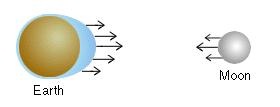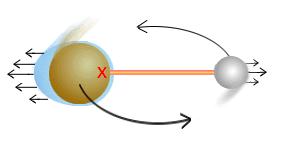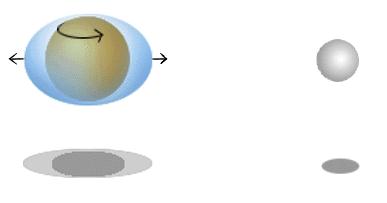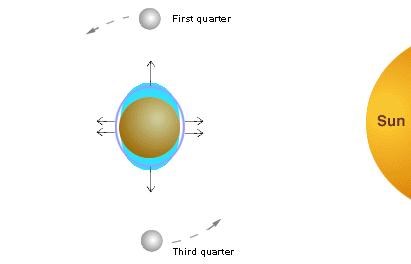“Tides” refer to the alternating rise and fall of the sea’s level at any specific spot on the earth’s surface during a particular day. Three different forces cause the waters of the oceans to swell and recede in different parts of the world:
|
I. The gravitational pull of the moon is the primary force causing the oceans’ water closest to the moon to bulge towards it, i.e. causing a high tide (1st fig). If this was the only force influencing the world’s oceans we’d experience a single low and high tide at any particular spot on the earth’s surface in every 24 hour cycle as this spot revolves past the moon.
|
 |
|
II. Contrary to general believe the moon is not spinning around the earth, they are rather spinning around each other with their center of gravity being the pivot point (X in 2nd fig). The inertia or centrifugal force resulting from this rotation causes the water on earth, farthest away from the pivot and in other words on the opposite side of the moon, to bulge (comparable to water that stays in the bucket when you swing it in a vertical circle).
|
 |
|
These gravitational and inertial forces are equal and constant, always pulling water towards the moon and directly away from the moon, resulting in a cycle of two high and two low tides every 24 hours as the earth rotates once around its axis (3rd fig).
|
 |
|
III. Similar to the force generated by the moon, the third force affecting the world’s oceans is the gravitational pull of the sun. The sun is 27 million times more massive than the moon, but it is also 390 times farther away. As a result, the sun has only 46% of the tide-generating force of the moon. The interplay between the moon and sun’s influences on the tides results in spring and neap tides.
The moon rotates around the earth once every month. When the earth, moon and sun are aligned (i.e. at new or full moon, 4th fig), the moon and sun’s gravitational forces are aligned and therefore reinforce each other. This results in high tides that are higher and the low tides that are lower than what they'd be with just the moon’s (or sun’s) pull alone. This is called spring tide.
|
 |
|
In contrast, when the moon is in its first or last quarter, the sun’s gravitational pull is perpendicular to that of the moon (5th fig). The sun therefore pulls water away from the areas where the moon is causing high tides, to areas with low tides, resulting in lower high tides and higher low tides. These are called neap tides.
Reference: OceanLink - all about the ocean.
|
 |
Finding the cache: The cache is placed on a rocky outcrop, ~200m off the beach, which you’ll only be able to access during spring low tides. Note that spring low tides are usually at their lowest the two days after full or new moon (this delay is referred to as the tide’s age). You can also get detailed tide level data for Simon’s Town from the SA Navy Hydrographic Office website. The container is a relative heavy “concrete rock”. Although the container will be on dry ground during spring low tide you’ll have to wade through some shallow channels to reach it and will therefore get wet up to your waist.
Maintenance: Maintaining this cache will obviously be a challenge. We’d therefore like to request that everyone please pitch in to help ensure it survives. PLEASE (i) dry the outside of the container before opening it, (ii) handle the log sheet with dry hands (taking a piece of dry cloth or tissue paper with is a good idea), (iii) ensure you close both the containers TIGHTLY, (iv) replace the container carefully w/o damaging the lid and (v) make sure it is inconspicuous. Only a water resistant log sheet is supplied, so please remember to bring a soft pencil or easy write pen to sign it.
| NB - to make the container watertight I had to use a plastic screw-cap container, which can get very sticky after some time in the salt water, so please take a set of adjustable pliers (windpomptang) with just in case you need them. |
Happy caching!
*******************************************
FTF: 